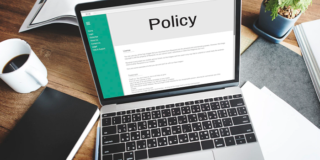What are Policies and Procedures?

Policies and procedures are not interchangeable, rather they go hand-in-hand.
A policy is a set of general guidelines which outlines the plan for an organization to handle the issue. Policies highlight the connection between a company’s vision and values and its day-to-day operations.
A procedure explains a specific action plan for carrying out a policy. Procedures tell employees how and when to tackle a situation.
The employees receive a well-rounded view of their organization by using policies and procedures together. By having policies and procedures in place, employees know about the organization’s culture, expectations from them, and the ways to achieve these things.
The importance of Policies and Procedures
Developing formal policies and procedures helps an organization to work more smoothly and efficiently irrespective of its size. The values and vision of the organization are communicated to the employees to make them understand the company’s expectations of them in certain situations.
There is no need for trial-and-error or micromanaging because the responsibilities of an individual as well as the team are clearly defined. The employees will understand how to carry out their work by just reading the workplace policies and procedures.
When handling HR issues, the formal policies and procedures save time and reduce stress. Where formal policies and procedures are not present, it results in an unnecessary waste of time and effort to agree on a course of action. Where the guidelines are already in place, the organization or the managers just need to enforce the policies, and the employees have to follow the procedures.
Implementing workplace policies and procedures improves the vision of an organization and also helps in ensuring that the relevant regulations are complied with. These also highlight the efficiency, professionalism, and stability of an organization. It can help in building a stronger relationship among businesses along with a better public reputation.
How to develop Policies and Procedures in the Workplace?
While creating the policies or procedures for a workplace, it is a good practice to start by reviewing the mission statement, vision, and values. Generally, a workplace policy should:
- Set out the objectives of the policy.
- Explain the reasons for the development of the policy.
- List who the policy applies to.
- Set out what is acceptable or unacceptable behavior.
- Set out the consequences of not complying with the policy.
- Provide the date of development or update of a policy.
Once policies and procedures are implemented, the employees should be informed of them and should also be trained on them. Employees can’t be expected to follow them without having any guidelines in place. The organization shall organize regular training sessions to keep the employees updated and on track.
Paychex WORX says that “employees may be more likely to embrace rules when they understand their purpose and that they are not meant to be a form of control or punishment.” To implement this, a positive attitude is required during the training sessions. Also, employees shall be given sufficient time to ask questions and clarify their doubts.
It is important to revise and update the policies regularly to promote the success of an organization, rather than keeping them untouched for decades after writing once. Along with an annual review, organizations should also consider updating the policies when:
- New equipment or software is adopted.
- There is an increase in accidents or failures on-site.
- There is a rise in complaints from the customers.
- They get a feeling of general confusion or there are increased staff questions regarding day-to-day operations.
- There is inconsistency in the performance of the employees.
- They feel increased stress levels across the workplace.
Types of Policies and Procedures Every Workplace Needs
Policies and procedures are required for a wide range of human resource sections of an organization. The following are some guidelines for organizations to follow while creating the policies and procedures:
Policies and Procedures for attendance
Absenteeism costs wages for the employee who is absent from the workplace, wages for a replacement worker, and delays and disruptions to the whole organization. Attendance policies are required to handle attendance and maintain consistency.
The guidelines on tardiness, vacation time, sick leave, appointments and paid volunteer hours can be included in these documents. Along with that, a period of notice can also be included. It is important to take into consideration the culture of an organization while incorporating such policies and procedures.
Policies and Procedures for employee conduct
The guidelines on employee conduct such as drugs and alcohol use, smoking, performance management, and discipline let employees know what is and are not acceptable behavior at work.
Policies and Procedures for use of company property
The company premises can be misused by the employees in various ways. It could include; renting out the company’s equipment to third parties, intentionally producing a scrap product that is actually being sold by the employee, taking vehicles for recreation, hosting their own websites on company servers, and even directing other employees to perform tasks that unknowingly benefit the ghost business. These are just a few examples of risks that could be faced by an organization.
The company property should be used by the employees in a proper manner and to do their jobs. There should be guidelines on the use and care of the company property along with details on the personal use of company property and permissions.
Policies and Procedures for harassment and discrimination
The average harassment lawsuit costs the employer $250,000 to defend. These incidents can be avoided by incorporating rules which will protect both the company and its employees.
The culture of the entire workplace gets affected by harassment and discrimination. It is better to develop policies and procedures to keep employees safe and to prohibit behaviors such as sexual harassment, bullying, verbal and physical harassment, stalking, hiring discrimination, and workplace discrimination. Companies should also include information on reporting such issues and explain that there will be no intervention by the company for reporting.
Policies and Procedures for internet and social media use
Any internet usage by the employees at the workplace should not be private. Ask employees to limit their personal usage of the internet. Everything done by them online, in the workplace should be legal, ethical, and appropriate. Add guidelines about what is and is not appropriate to post on social media regarding your organization as well.
Policies and Procedures for Health and Safety
The organization and its employees are at great risk without strong policies and procedures for health and safety. Protecting employees’ safety and well-being should be the top priority of every organization. When writing your health and safety policies, include information about how to deal with illness or injury at work, equipment safety guidelines, and how to report a health or safety concern. The procedure should also include details on how to handle problems in the event of a fire or natural disaster.
Policies and Procedures for expenses
The company should have an expense reimbursement policy. It is to reimburse employees for the expense of travel or things purchased for work. The acceptable expenses for reimbursement (airfare class, transportation, meals, etc.) should be explained. The company shall also include procedures on how to submit a reimbursement claim.
Policies and Procedures for remote work
Companies should provide the flexibility to generally work remotely, especially in specific situations such as the COVID-19 pandemic. It needs to ensure that the set-up is both safe and runs smoothly when allowing employees to work from home. There should be a general remote work policy on who is allowed to work remotely and how often. What hours do remote workers need to be available? What communication standards must they meet? Will you provide necessary work equipment or reimburse employees for their purchases?
Conclusion
To make the workplace run more efficiently and smoothly, policies and procedures play a great role. However, these are only effective once you enforce them. The enforcement of such policies and procedures helps to promote the vision of the company as well as highlights that the decision-making processes of an organization are uniform and consistent across cases.
An organization puts itself at risk by not enforcing procedures. Having formal policies and procedures helps in strengthening the company’s position when an allegation is raised against the company by any employee or a third party.
You Might Also Like:
Along with this document, make sure you see these other templates in our library:






